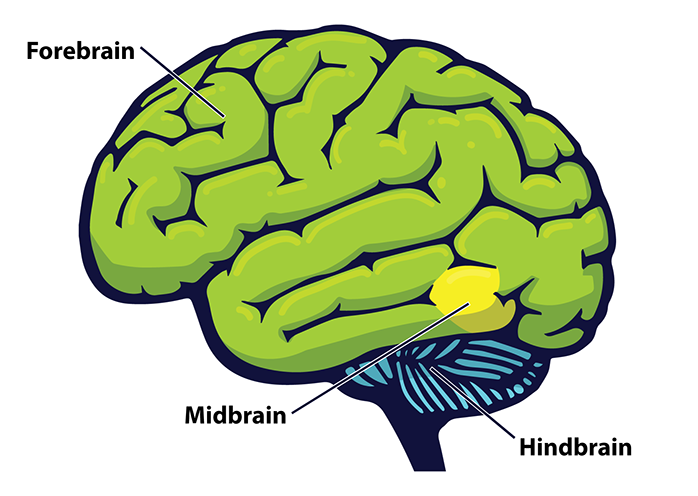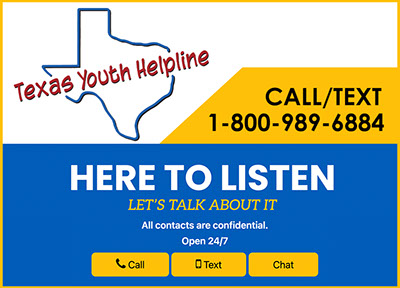
Did you know the brain is like the ultimate multitasking machine? It helps make decisions, manage emotions, remember important things like an upcoming test, and even controls how the human body moves. Before we can talk about mental health, it’s important to understand how the brain works. Especially, the teen brain. As a teen, you go through one of the most exciting and sometimes frustrating times of life, and the brain is at the center of all your growth. In this module, we’ll review how the teen brain is different from the adult brain and what mental health actually means.
What is “Teen Brain?”
The brain has three different units, each with its own job, but they all work together. You can think of how the teen brain functions like a class assignment for a group project. Each person has different skills they are good at, each person responds in different ways, and sometimes people don’t always get along with each other. For example, one person may be good at researching the issue, another at organizing materials, but the other might need more time to understand the assignment, which can be frustrating.
Just like the group project, parts of the teen brain are ready to go, while other sections need more time to understand. Because these areas of the brain are developing at different speeds, young people can feel a lot of emotions at once. One minute might be a happy and exciting feeling, and the next minute, sad, mad, or overwhelmed. This happens because parts of the brain that control these feelings are learning how to work together with other sections of the brain that are also developing. Your brain will be “under construction” until 25-26 years old.
Remember, it’s completely normal to have these mixed emotions. Everyone experiences them as they grow and mature. Let’s take a look at the three different units of the brain, including areas that are developing during the teen years.

Front Brain (aka Forebrain):
This part of the brain is located at the front, just behind your forehead, and it’s massive. It’s responsible for a lot of important things like problem-solving, memory, moving your arms and legs when you walk, run, or dance, and more. As you grow, the front brain grows, too, and helps you make better choices and manage your emotions.
The prefrontal cortex is also located in the front brain, and it functions like your brain’s boss. It takes care of all the big stuff, like making decisions, being organized, planning, paying attention, and expressing your personality.
Middle Brain (aka Midbrain):
The midbrain is the middle part of the brain and is located above the brainstem. Even though this part of the brain is small, it’s responsible for major functions, including hearing, seeing, controlling movement like your eyes, and keeping you awake and alert.
The amygdala is part of the middle brain and plays a big role in your emotions. In short, it helps you process and respond to emotions, especially those tied to survival or things that feel intense like fear, anxiety, and excitement.
In the teen brain, the amygdala is very active, which makes emotions feel heightened or more intense compared to an adult. It also develops earlier than the prefrontal cortex, the part of the brain that makes rational thoughts. This is why teens respond to certain situations based on how they feel because thinking rationally is still developing. That’s why some decisions like choosing between studying or watching Netflix can feel like a hard decision.
Lower Brain (aka Hindbrain):
The hindbrain includes the upper part of the spinal cord, the brain stem, and a wrinkled ball of tissue called the cerebellum. This part of the brain is on autopilot. It controls the body’s vital functions that keep your body running smoothly, such as breathing, heart beats, and reflexes.
The cerebellum coordinates movement and is involved in learned movements. When you play the piano or hit a tennis ball, you are activating the cerebellum. Just like the front brain and middle brain, the cerebellum is still growing, too. This means coordination, balance, and muscle control are all still developing as a teen.
Brain Match Up
Let’s see what you remember! In the activity below, match the correct action or emotion to the correct part of the brain that controls the feeling or function.
Word Bank
Planning
Breathing
Focusing
Anxiety
Walking
Reflexes
Anger
Happiness
Remembering
Balancing
Click on the box to reveal the answer
Front Brain
Planning
Remembering
Focusing
Middle Brain
Anxiety
Anger
Happiness
Low Brain
Walking
Balancing
Breathing
Reflexes
What is Mental Health?
Now that you understand how the brain functions, what is mental health and how is it connected?
Mental health is all about how you feel, think, and act, and how you handle life’s challenges. It affects everything you do, from how you handle stress to how you relate to others and how you feel about yourself. It can positively and negatively affect your emotions, how you think about things, your relationships with friends and family, and how you view yourself.
Good Mental Health vs. Bad Mental Health
Good mental health helps you manage your emotions in a healthy way; whether you're feeling happy, sad, angry, or stressed. It’s okay to feel these emotions, but good mental health helps you understand and deal with them in a positive way. When you're struggling, it can feel like your mind is clouded or overwhelmed, so positive mental health lets you think clearly, make decisions, and solve problems. When your mental health is in a good place, you’re more likely to feel confident and proud of who you are, even when things aren't perfect.
Bad mental health is more than feeling sad or stressed for a short period of time. It means these feelings have affected your daily life, relationships, and overall well-being. Here’s what it might look like:
Constant Sadness:
Feeling Overwhelmed:
Avoiding Social Situations:
feeling sad, down, or moody for no clear reason and it’s hard to be happy
feeling like everything is too much to handle
avoiding friends, family, or things that were once fun
It’s tough experiencing these emotions, so it’s important to check-in with friends and family or reach out for help. Talking to a trusted friend, family member, or teacher can help make things better. Texas youth can also text the Texas Youth Helpline at 1-800-989-6884 for free, 24/7 help.
To understand mental health a little better, watch the video below of Leanne Foell, a teen mental health therapist, as she explains what good mental health looks like and how it can keep teens from turning to tobacco and other drugs.

Teen Mental Health
Everyone, whether it’s a teen or adult, has mental health. During your teenage years, you're experiencing new challenges like school, relationships, and finding your independence. Teen mental health is all about how you feel, think, and cope during a time of big changes in your life.
But the teen brain is still growing, especially in areas that control emotions, decision-making, and self-control. Things like hormones, genetics, school, and social pressures can make emotions feel more intense. How teens respond to challenges can either support or harm their mental health now and later in life as an adult. Learning the difference between healthy and unhealthy responses can help you make choices that support good mental health.
Watch the video below as Leanne explains what healthy and unhealthy responses look like.
To help you learn more about healthy versus unhealthy responses to a stressful situation, read through each scenario below.
Click on the box to reveal the answer
Elena had an argument with her best friend and feels stressed about it. She decides to avoid her friend and spend all night scrolling through social media instead of sharing her feelings with her friend.
Answer – Unhealthy
Liam thought vaping would help calm is anxiety about finals, so he started vaping because he heard it can help keep him calm.
Answer – Unhealthy
Alex’s classmates start gossiping about another student and pressure her to join in. Alex feels uncomfortable but decides to speak up, saying it is mean to gossip about someone. She encourages her classmates to change the subject to Friday night’s game.
Answer – Healthy
Veronica is feeling anxious about presenting her history project to her class. She knows this presentation’s grade will go towards her overall semester grade. Veronica decides to channel her nerves into practicing her speech with family and friends. Afterwards, she felt proud when her final grade was posted with an A.
Answer – Healthy
Think of Mental Health as a 3-Course Meal
Mental health can be difficult to understand, but in the video below, Leanne explains how mental health is a lot like a three-course meal with appetizers, dinner, and desert. Make sure your plate is full of a healthy main course!
Sources for module 1 include: National Institute of Health, World Health Organization, U.S. Health and Human Services.
Training Module
Modules
Home
Say What! EST. 2011
Phone
512.245.8082
Mailing Address
Texas School Safety Center
ATTN: Say What Program
Texas State University
601 University Drive
San Marcos, TX 78666

Say What! was created and designed by young people from across Texas and connects students interested in eliminating tobacco from their schools and communities. The Say What! movement is funded by the Texas Department of State Health Services through a contract with the Texas School Safety Center at Texas State University.

